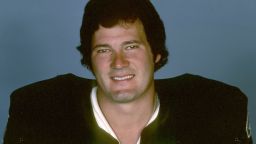Story highlights
Nancy Hogheads-Makar and Phil Villapiano say they will donate their brains to science
Brains of more than 90% of former football players have been found to have CTE
Three-time Olympic gold-medal swimmer Nancy Hogshead-Makar and former Oakland Raider linebacker Phil Villapiano announced on Wednesday that they will be donating their brains to science.
They are part of a growing number of professional athletes concerned about chronic traumatic encephalopathy, known as CTE, a degenerative brain disease caused by repeated hits to the head.
A devastating disease
CTE can result in Alzheimer’s-like symptoms such as aggression, memory loss and mood swings. It can also potentially lead to suicide. The only way to definitively diagnose the disease is after death. Scientists are trying to find a way to identify CTE in the living and develop a treatment.
Hogshead-Makar and Villapiano join Cincinnati Bengals offensive tackle Eric Winston, soccer player Brandi Chastain, NASCAR and racing legend Dale Earnhardt Jr. in promising their brains to the Department of Veterans Affairs-Boston University CLF Brain bank. Their announcement was part of the VA’s Brain Trust, an event bringing together researchers, policy makers, athletes, clinicians, and private industry leaders together to tackle the issues of brain trauma.
Dr. Ann McKee, who helps lead the work at the brain bank, has found the disease in 200 people, ranging from high school to professional football players, boxers, and veterans. “It’s much more common than we want to realize,” said McKee. McKee has documented the disease in the brains of more than 90% of former professional football players. San Diego Charger Junior Seau and the Chicago Bears’ Dave Duerson were diagnosed with CTE. Earlier this year, it was found that both former Minnesota Vikings Fred McNeill and NFL Hall of Famer Ken Stabler also had the disease.
Leaving a legacy for future athletes

Villapiano was teammates with Stabler on the Raiders in the early 1980s and was shocked to hear of his teammate’s diagnosis.
After hearing the news, Villapiano said he immediately called Stabler’s girlfriend and asked how he could donate his brain.
He knew his head had taken some hits in his career.

“When you make the perfect tackle, it’s like hitting the perfect drive. If you hit a guy with your helmet right in the ear hole, it will ‘whop!’” It’s such a great sound,” he said. “How stupid is that? I loved it though.”
But it’s hard to watch his son play in college now. “I don’t tell him I’m scared for him.”
Join the conversation
Hogshead-Makar won three Olympic golds and a silver medal in the the 1984 Olympic Games, making her the most decorated swimmer of the 1984 games.
While CTE has not been documented in a swimmer, Hogshead-Makar said that she was donating her brain in hopes of advancing the research around the disease and to make sports safer for all children. “We don’t want it to just be about football and men’s basketball. This is a youth sport movement,” she said.






















